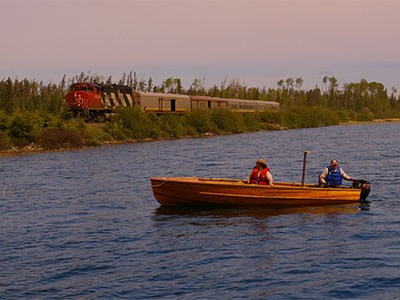Passenger rail preservationists are facing a steep grade after Transport Canada pulled a critical federal subsidy to restore the northeastern Ontario service.
Federal Transport Minister Marc Garneau made it known during a trip to Sault Ste. Marie on July 20 that his government would no longer honour a $5-million-over-three-years commitment made by the previous Harper government to subsidize service on the 470-kilometre-long track.
But this is not the end of the line, insists Missanabie Cree Chief Jason Gauthier, who heads a working group seeking to revive the Sault-to-Hearst service after it was terminated by CN Rail last summer.
“We put a lot of political pressure on Garneau to make a decision and I think he made the wrong decision. But we’re not going anywhere.”
According to Garneau and Transport Canada, the passenger service is no longer eligible to tap into the Remote Passenger Rail Program, and the minister is passing the buck over to Indigenous and Northern Affairs Canada (INAC).
Under their new criteria, the subsidy is only available to remote communities where rail is the only method of access.
“It is only used in cases where rail is literally the only way to get in and out of the communities (and ) our judgement is that the Sault-to-Hearst rail line, the communities along there, most of them have alternative ways of accessing highways,” Garneau told SooToday.com.
"We have to reserve funding for where railways are the only source, the only way to move around, and there are a couple in Canada where we're doing that."
Gauthier disputes their rationale, arguing that communities like Oba will be cut off and many forestry roads leading into cottages are too dangerous to drive.
“My real disappointment is that they don’t understand remote passenger service like they used to.
They supported this from the beginning as a remote passenger service and now I don’t know why. I’m not going to presuppose but I’m a little confused why they’re not taking that same position.”
Transport Canada does provide subsidies for track maintenance and operating expenses to the Keewatin Railway Company in northern Manitoba and Tshiuetin Transportation, running between Quebec and Labrador. Both are First Nation-run railroads. Their funding runs out in 2018.
Gauthier’s group wanted to use the subsidy to bring in Keewatin Rail to run the three-times-a-week service that caters to outdoor adventure tourists, cottagers, First Nations and residents along the line.
After a “fantastic” meeting with CN officials in Toronto on July 8, Gauthier said they had permission to do so, and was handed a letter of support from CN’s vice-president of operations.
Gauthier, who received a letter from Transport Canada denying the subsidy earlier this week, admitted to being “a little disappointed,” but the goal remains to chase operating funds.
“Maybe there’s a path forward (with INAC) if there isn’t proper financing for this.”
Passenger service between Sault and Hearst has operated since 1914. Much to the dismay of remote lodge owners, the schedule had been revised and reduced when CN acquired the line in 2001.
Railmark Holdings was selected by CN last year as a replacement operator, but the Michigan railroader was unable to obtain financing from lenders. Transport Canada was reluctant to flow funds to Railmark and CN finally terminated service in mid-July 2015.
The popular Agawa Canyon excursion service continues to run on the same track.
Since 2010, Transport Canada has been working on new funding criteria and what constitutes a ‘remote community,’ examining factors like year-round access, population size and the permanence of that population.
Gauthier said he’s undeterred by the challenge.
“Anybody that knows me knows I’m not the type of person to give up. I’m going to continue on until there’s no path forward and I think Garneau has given us a path forward with possible INAC funding.
We’ll continue to push forward until we know for sure there is no possibility.”




